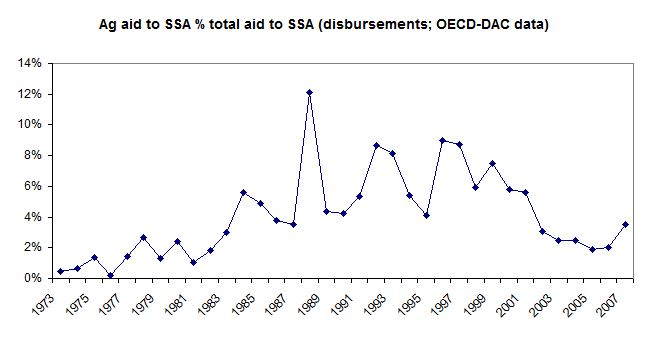The Gates Foundation states that “funders have sharply cut their international aid to agricultural development over the past few decades.” It is implied that this is a major reason for the failure to see a “Green Revolution in Africa.”
We have been unable to locate support for this claim.
Using data from OECD – the most reliable source of official aid flows as far as we know – we graphed the proportion of (disbursed) aid to Africa that was classified in the “agriculture” sector since the 1970s. It’s possible that the numbers are artificially depressed for early years due to less standardized reporting, but we see no trend of the type the Gates Foundation describes.

It’s frustrating that the Gates Foundation doesn’t provide a source for its claim. In general, the material on its website is at a very broad level and does not make it possible for people curious about its underlying reasoning to drill deeper. That means that any criticism or examination of its work has to be either very superficial or done offline (i.e., in direct communication with the Foundation, an opportunity few people seem to get easily or often).
Added 10/30/09: here’s our source data

Comments
Does the “agriculture” sector include food aid?
It doesn’t appear so. “Dev. Food Aid/Food Security Ass.” is a separate category from “Agriculture.” The subcategories of “Agriculture” are as follows (I don’t have info beyond the labels, but they seem fairly aligned with the kinds of things the Gates Foundation is now investing in).
AGRARIAN REFORM
AGRICULTURAL ALTERNATIVE DEVELOPMENT
AGRICULTURAL CO-OPERATIVES
AGRICULTURAL DEVELOPMENT
AGRICULTURAL EDUCATION/TRAINING
AGRICULTURAL EXTENSION
AGRICULTURAL FINANCIAL SERVICES
AGRICULTURAL INPUTS
AGRICULTURAL LAND RESOURCES
AGRICULTURAL POLICY & ADMIN. MGMT
AGRICULTURAL RESEARCH
AGRICULTURAL SERVICES
AGRICULTURAL WATER RESOURCES
FOOD CROP PRODUCTION
INDUSTRIAL CROPS/EXPORT CROPS
LIVESTOCK
LIVESTOCK/VETERINARY SERVICES
PLANT/POST-HARVEST PROT. & PEST CTRL
To be clear, I am not at all saying that the chart above *debunks* the Gates Foundation’s claim. My only point in showing it is that it isn’t clear what the Gates Foundation is referring to (the most obvious source of data doesn’t appear to be it).
Gates is probably relying on the same OECD dataset, but looking at the “commitments” rather than “disbursements” data. Using the commitments data, the agriculture percentage is in the high teens for most of the ’70s and ’80s, falls sharply during the ’90s, and is at or below 5% from 2000 onward.
The following analyses show similar downward trends, both as percentages and as absolute dollar amounts, though only the last one breaks out sub-Saharan Africa.
http://www.oecd.org/dataoecd/40/43/2094403.pdf
http://www.oecd.org/dataoecd/40/33/40556614.pdf
http://www.isgmard.org.vn/Information%20Service/Report/General/oda%20in%20agriculture-DFID.pdf
http://rmportal.net/library/content/frame/donor-aid-to-african-agriculture.pdf/
It would be interesting to know why all of these favor the commitments rather than the disbursement data. (Looking at the spreadsheet underlying your chart, I’d guess it’s because donors didn’t consistently report much disbursement data to the OECD until the 90’s.)
However, even assuming the commitments data more accurately reflects actual spending, I agree this doesn’t justify that implication that agriculture in SSA has low productivity because donors cut funding. It’s just as probably that donors cut funding because of the disappointing results from their agricultural investments. And none of this sheds much light on whether current approaches and/or the current context are different enough from the past that additional investment is now likely to yield better results.
On the food aid question, much of what the US labels food aid might show up under other categories (including agriculture) in the OECD data. At least a couple of the major US food aid programs work as follows: the US gives Charity X $10 million worth of food, which Charity X then transports to and sells on the open market in, e.g., Uganda. Charity X then uses the proceeds from that sale to fund its programs (whether health, education, microfinance, agricultural etc.) in Uganda. I think this type of food aid gets counted as funding to the sector in which the proceeds are spent.
Geoff, thanks for the info, particularly re: commitments vs. disbursements. If the commitment data is a better representation of what was actually disbursed, then it appears to be consistent with (though, as you say, not providing particular support to) the Gates Foundation’s claim.
Re: food aid, it doesn’t seem like the point you’re making has much bearing on the meaning of the “Agriculture aid” figure.
Comments are closed.